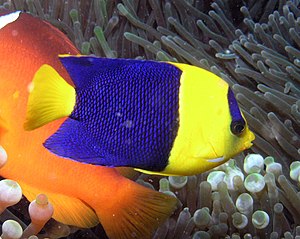Blue and yellow angelfish
| Blue and yellow angelfish | ||||||||||||
|---|---|---|---|---|---|---|---|---|---|---|---|---|

Blue and yellow angelfish ( Centropyge bicolor ) |
||||||||||||
| Systematics | ||||||||||||
|
||||||||||||
| Scientific name | ||||||||||||
| Centropyge bicolor | ||||||||||||
| ( Bloch , 1787) |
The blue-yellow pygmy angelfish ( Centropyge bicolor ) lives in the tropical Indo-Pacific from the coasts of Malaysia over the Great Barrier Reef to Samoa .
features
The fish reach a length of 15 centimeters. This makes it one of the growing angelfish species. The two-colored body is characteristic of the species, which also gave it its German and scientific name. The front body, the paired fins, the caudal fin and the upper edge of the dorsal fin are intensely yellow. The back of the body, the anal fin and most of the dorsal fin are blue. In addition, a blue band runs over the head from one eye to the other. The sting on the gill cover, which is typical of all angelfish, can be light blue or whitish.
Fin formula : dorsal XV / 15–17, anal III / 17–18.
Way of life
The blue-yellow dwarf angelfish lives in coral-rich lagoons and steep outer reefs at depths of one to 25 meters and always stays close to the bottom and to hiding places. Young animals prefer shallow water, while adult fish tend to be below ten meters. The blue-yellow angelfish lives in harem groups of one territorial male and five to ten females. Like all angelfish, the blue-yellow dwarf angelfish is a protogynous hermaphrodite, which means that the fish are initially female when they reach sexual maturity and after some time transform into males. In a harem association, the strongest female changes her sex, if z. B. the male has died or if the number of ten females is exceeded. The female transformed into a male then forms a new harem group.
Hazards and protective measures
Since this species is widespread and is only occasionally caught for aquariums, it has not any effect on the population of this species. Furthermore In this type also comes in protected areas before, so the IUCN classifies this species as Least Concern (Near Threatened) a .
literature
- Frank Schneidewind: Angelfish . 1999, Tetra Verlag, ISBN 3-89745-137-9
- Roger C. Steene: Butterfly and Angelfish, Volume 1 . 1977, Mergus Verlag, ISBN 3-88244-001-5
- Hans A. Baensch / Robert A. Patzner: Mergus Sea Water Atlas Volume 6 . Mergus-Verlag, Melle, ISBN 3-88244-116-X
- Allen, GR, Steene, R. & M. Allen (1998): A Guide to Angelfishes & Butterflyfishes . Odyssey Publishing / Tropical Reef Research.
- Robert F. Myers: Micronesian Reef Fishes . 1999, Coral Graphics. ISBN 0962156450 .
- Randall, JE, Allen, GR & RC Steene (1997): Fishes of the Great Barrier Reef and Coral Sea . Crawford House Press, Honolulu.
Web links
- Blue and yellow angelfish on Fishbase.org (English)
Individual evidence
- ↑ Centropyge bicolor in the IUCN Red List of Threatened Species 2013.2. Listed by: Pyle, R., Myers, R. & Rocha, LA, 2009. Retrieved June 2, 2014.